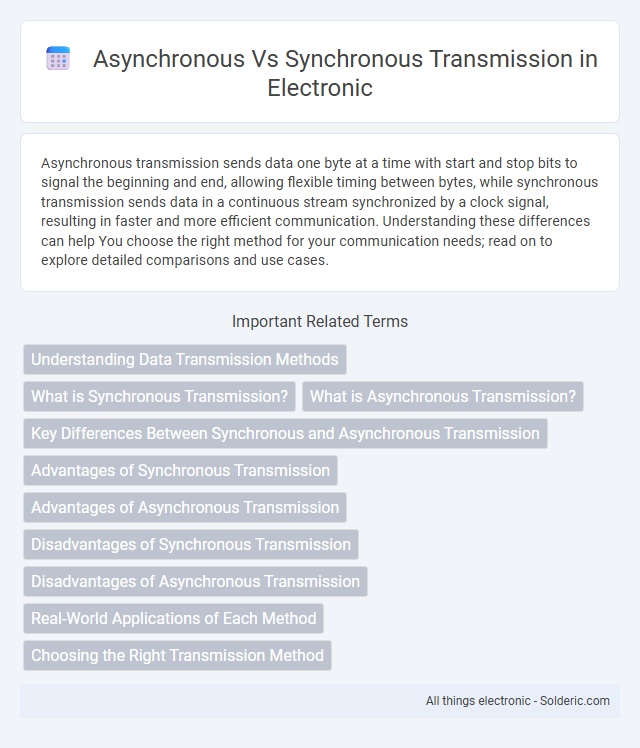Asynchronous transmission sends data one byte at a time with start and stop bits to signal the beginning and end, allowing flexible timing between bytes, while synchronous transmission sends data in a continuous stream synchronized by a clock signal, resulting in faster and more efficient communication. Understanding these differences can help You choose the right method for your communication needs; read on to explore detailed comparisons and use cases.
Comparison Table
| Feature | Asynchronous Transmission | Synchronous Transmission |
|---|---|---|
| Data Transfer | Transmits data one byte or character at a time with start and stop bits | Transmits data in continuous streams without start/stop bits using clock signals |
| Synchronization | No clock synchronization; uses start/stop bits | Requires clock synchronization between sender and receiver |
| Efficiency | Less efficient due to overhead of start/stop bits | More efficient with higher data rates and less overhead |
| Complexity | Simple and easier to implement | More complex hardware and software needed |
| Use Cases | Suitable for low-speed or intermittent data transmission | Ideal for high-speed and bulk data transfer |
| Error Handling | Errors easier to detect with start/stop bits | Error detection requires additional mechanisms |
Understanding Data Transmission Methods
Asynchronous transmission sends data in individual bytes or characters framed by start and stop bits, allowing devices to transmit at irregular intervals without synchronization. Synchronous transmission transmits data in a continuous stream, synchronized by a shared clock signal, enabling higher data rates and efficiency. Choosing between these methods depends on factors like transmission speed, complexity, and error tolerance in communication systems.
What is Synchronous Transmission?
Synchronous transmission is a method of data transfer where bits are sent in a continuous stream synchronized by a shared clock signal, allowing multiple data bytes to be transmitted without start and stop bits. This technique enhances efficiency by reducing overhead and is commonly used in high-speed communication systems like Ethernet and fiber optics. Your data is transferred reliably and quickly due to precise timing coordination between the sender and receiver.
What is Asynchronous Transmission?
Asynchronous transmission allows data to be sent one byte at a time, with start and stop bits marking the beginning and end of each byte, enabling flexible timing between transmissions. This method eliminates the need for a shared clock signal, making it ideal for irregular or low-speed data communication. You benefit from asynchronous transmission in environments where data packets are sent intermittently rather than in a continuous stream.
Key Differences Between Synchronous and Asynchronous Transmission
Synchronous transmission transfers data in a continuous stream using a shared clock signal, ensuring faster and more efficient communication, while asynchronous transmission sends data in individual packets framed by start and stop bits, making it simpler but slower. Synchronous transmission is ideal for high-speed, large-volume data exchanges typically used in network and telecommunications, whereas asynchronous transmission is suited for intermittent data transfer such as keyboard inputs or serial ports. Error detection and data synchronization in synchronous transmission rely on the clock, whereas asynchronous transmission handles synchronization with start/stop bits and parity checks.
Advantages of Synchronous Transmission
Synchronous transmission offers higher data transfer rates and efficient use of bandwidth compared to asynchronous methods, making it ideal for large volumes of data. It reduces transmission errors by synchronizing the sender and receiver clocks, ensuring accurate data timing. You benefit from improved performance and reliability in network communications using synchronous transmission.
Advantages of Asynchronous Transmission
Asynchronous transmission offers significant advantages such as simplified synchronization requirements, allowing data to be sent intermittently without a continuous clock signal. This approach reduces transmission overhead and enables efficient communication in environments with irregular or sporadic data flow. Its flexibility and lower latency make asynchronous transmission ideal for low-speed, cost-sensitive applications like serial ports and keyboard interfaces.
Disadvantages of Synchronous Transmission
Synchronous transmission requires precise timing between the sender and receiver, making it vulnerable to synchronization errors that can disrupt data flow. The need for continuous synchronization increases system complexity and cost, often requiring more advanced hardware and software management. Your communication efficiency may suffer during transmission interruptions, as synchronous methods are less tolerant of delays or data loss compared to asynchronous transmission.
Disadvantages of Asynchronous Transmission
Asynchronous transmission suffers from lower efficiency due to the inclusion of start and stop bits with every character, increasing overhead and reducing data throughput. It also experiences higher susceptibility to errors in noisy environments since each character is transmitted independently without continuous synchronization. The variable timing intervals between characters can lead to synchronization issues, complicating the receiver's ability to correctly interpret the data stream.
Real-World Applications of Each Method
Asynchronous transmission is widely used in low-speed, intermittent data communication applications such as keyboard inputs, serial ports, and simple sensor data exchanges where data is sent in small, irregular bursts. Synchronous transmission is preferred in high-speed, continuous data transfer scenarios like Ethernet networks, video streaming, and real-time financial trading systems due to its efficiency and reduced overhead. Industries such as telecommunications and data centers rely on synchronous methods for bulk data transfers, while embedded systems and industrial control often utilize asynchronous transmission for flexibility and simplicity.
Choosing the Right Transmission Method
Choosing the right transmission method depends on your data transfer needs and system requirements. Asynchronous transmission suits low-speed, intermittent data with start and stop bits ensuring accuracy, while synchronous transmission excels in high-speed, continuous data streams with timing signals enabling efficient data flow. Evaluating factors like latency, bandwidth, and error handling will help you determine whether asynchronous or synchronous transmission best fits your communication system.
Asynchronous vs Synchronous transmission Infographic

 solderic.com
solderic.com